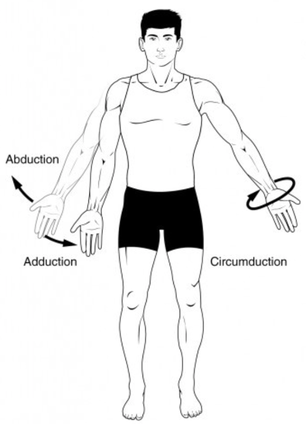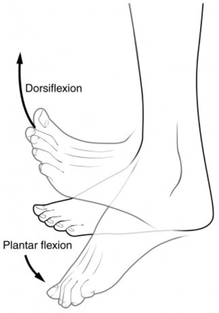Med-Fit Tech Assistant
Human Anatomy - Learning Module #1
Body Mechanics
Part B
Part B: Major Body Movements
Learning Objectives:
Joints: Certain body parts are designed to move much more than other body parts. These parts are characterized by having one or more synovial joints. These include:
Movements
Flexion and Extension
Learning Objectives:
- Identify the joints that allow for the body’s major movements
- Define and identify the major body movements
- Demonstrate the different types of body movements
Joints: Certain body parts are designed to move much more than other body parts. These parts are characterized by having one or more synovial joints. These include:
- Neck
- Shoulder
- Elbow
- Wrist
- Fingers
- Trunk
- Hip
- Knee
- Ankle
- Toes
Movements
Flexion and Extension
- From the anatomical position, flexion and extension are movements that take place within the sagittal plane and involve anterior or posterior movements of the head, trunk, arms, forearms. hands, fingers, thigh, legs, foot, and toes.
Flexion and Extension of the Arm and Leg
Abduction (aB-duction) and Adduction (aD-duction) and Circumduction
From the anatomical position,
From the anatomical position,
- ABduction and ADduction are movements that take place within the frontal plane and involve lateral or medial movements of the arms, hands, and thighs.
- Circumduction is a three-dimensional movement (does not stay within a plane) and involves a circular movement of the head, trunk, arms, hands, thighs, and foot. (Not to be confused with Rotation.)
Abduction and Adduction of the Right Arm,
and Circumduction of the Left Arm
and Circumduction of the Left Arm
Rotation
- From the anatomical position, rotation is a movement that takes place within the transverse plane and involves twisting of the neck, trunk, arm, or thigh. (Not to be confused with Circumduction.)
Rotation of the Head and Left Thigh
Pronation and Supination – Special names for Rotation of the Forearm
From the anatomical position, pronation is the rotational movement of the forearm that changes the orientation of the palm from forward to backward. Supination is the reverse of pronation - the rotational movement of the forearm that changes the orientation of the palm from backward to forward.
If the arm is in a horizontal position, pronation rotates the forearm to orient the palm downward, and supination rotates the forearm to orient the palm upward.
From the anatomical position, pronation is the rotational movement of the forearm that changes the orientation of the palm from forward to backward. Supination is the reverse of pronation - the rotational movement of the forearm that changes the orientation of the palm from backward to forward.
If the arm is in a horizontal position, pronation rotates the forearm to orient the palm downward, and supination rotates the forearm to orient the palm upward.
Pronation and Supination of the Left Forearm
Dorsiflexion and Plantar Flexion - Special names for Extension and Flexion of the Foot
- Dorsiflexion lifts the front of the foot, so that the top of the foot moves toward the anterior part of the leg.
- Plantar flexion lifts the heel of the foot off the ground or points the toes downward.
Dorsiflexion and Plantar Flexion of the Foot
Inversion and Eversion - Special names for Medial and Lateral Flexion of the Foot
- Inversion is medial (inward) flexion of the foot (the bottom of the foot moves toward the midline).
- Eversion is lateral (outward) flexion of the foot (the bottom of the foot moves away from the midline).
Inversion and Eversion of the Left Foot
Note: The foot has a greater range of inversion than eversion motion. These are important motions that help stabilize the foot when walking or running on an uneven surface and aid in the quick side-to-side changes in direction used during active sports such as basketball, tennis, or soccer.
Glossary of Body Movements
Abduction - movement in the coronal plane that moves the arms or legs laterally, away from the midline of the body.
Adduction - movement in the coronal plane that moves the arms or legs medially, toward or across the midline of the body.
Circumduction - circular motion of the head, trunk, arm, hand, thigh, or foot that is produced by the sequential combination of flexion, abduction, extension, and adduction.
Dorsiflexion - movement at the ankle that brings the top of the foot toward the anterior leg.
Eversion - movement in which the bottom of the foot is turned laterally, away from the midline.
Extension - backward movement in the sagittal plane of the head, trunk, arm, hand, or thigh, or forward movement of the leg at the knee when returning it to the anatomical position from a flexed position.
Flexion - forward movement in the sagittal plane of the head, trunk, arm, forearm, hand, or thigh, or backward movement of the leg at the knee.
Inversion - movement in which the bottom of the foot is turned medially, toward the midline.
Lateral Flexion - bending of the head or trunk toward the right or left side.
Lateral Rotation - movement of the arm at the shoulder or the thigh at the hip that moves the anterior surface of the arm or thigh away from the midline of the body.
Medial Rotation - movement of the arm at the shoulder or the thigh at the hip that brings the anterior surface of the arm or thigh toward the midline of the body.
Plantar Flexion - foot movement at the ankle in which the heel is lifted off the ground or pointing the toes downward.
Pronation - forearm motion that moves the palm of the hand from forward to the backward.
Rotation - twisting of the neck or trunk. (Not to be confused with circumduction).
Supination - forearm motion that moves the palm of the hand from backward to forward.
Adduction - movement in the coronal plane that moves the arms or legs medially, toward or across the midline of the body.
Circumduction - circular motion of the head, trunk, arm, hand, thigh, or foot that is produced by the sequential combination of flexion, abduction, extension, and adduction.
Dorsiflexion - movement at the ankle that brings the top of the foot toward the anterior leg.
Eversion - movement in which the bottom of the foot is turned laterally, away from the midline.
Extension - backward movement in the sagittal plane of the head, trunk, arm, hand, or thigh, or forward movement of the leg at the knee when returning it to the anatomical position from a flexed position.
Flexion - forward movement in the sagittal plane of the head, trunk, arm, forearm, hand, or thigh, or backward movement of the leg at the knee.
Inversion - movement in which the bottom of the foot is turned medially, toward the midline.
Lateral Flexion - bending of the head or trunk toward the right or left side.
Lateral Rotation - movement of the arm at the shoulder or the thigh at the hip that moves the anterior surface of the arm or thigh away from the midline of the body.
Medial Rotation - movement of the arm at the shoulder or the thigh at the hip that brings the anterior surface of the arm or thigh toward the midline of the body.
Plantar Flexion - foot movement at the ankle in which the heel is lifted off the ground or pointing the toes downward.
Pronation - forearm motion that moves the palm of the hand from forward to the backward.
Rotation - twisting of the neck or trunk. (Not to be confused with circumduction).
Supination - forearm motion that moves the palm of the hand from backward to forward.
Module #1: LAB
From the anatomical position, practice the following body movements in front of a full-length mirror, name the body region or structure that allows the body to perform the movement, and note the different ranges of motion of the joints in the different directions when performing the body movements.
Q: Which body part has the greatest range of motion? (head, trunk, arm, hand, leg, or foot?)
- Flexion of the head, trunk, arms, forearms, hands, thighs, legs
- Extension of the head, trunk, arms, forearms, hands, thighs, legs
- Abduction of the arms, thighs, hands
- Adduction of the arms, thighs, hands
- Circumduction of the head, trunk, arms, hands, thighs, feett
- Rotation (left and right) of the head, trunk
- Rotation (medial/internal and lateral/external) of the arms, thighs
- Pronation and Supination of the forearm
- Dorsiflexion & Plantar Flexion of the feet
- Inversion & Eversion of the feet.
Q: Which body part has the greatest range of motion? (head, trunk, arm, hand, leg, or foot?)





